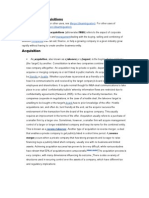Nonono
Nonono
Uploaded by
Yash JaiswalCopyright:
Available Formats
Nonono
Nonono
Uploaded by
Yash JaiswalOriginal Description:
Original Title
Copyright
Available Formats
Share this document
Did you find this document useful?
Is this content inappropriate?
Copyright:
Available Formats
Nonono
Nonono
Uploaded by
Yash JaiswalCopyright:
Available Formats
State the difference between Mergers & Acquisitions
ACQUISITIONS MERGERS
Meaning
An acquisition is a cycle wherein one organisation A merger is a cycle wherein more than
assumes or takes over the responsibility for another one organisation’s approach functions
organisation. as one.
Issuance of Shares
No new shares are issued in case of acquisitions. New shares are issued in case of
mergers.
Mutual Consent and Decisions
The choice of acquisitions is probably not shared, or of A merged business entity is settled
mutual consent in nature; in the event that the acquiring upon by common assent and mutual
organisation assumes control over one more venture consent of the involved organisations.
without the acquired company’s assent, it is named an Rather it is a planned and friendly one.
unfriendly takeover or hostile takeover.
Company’s Name
The obtained or acquired organisation, for the most part, The merged business entity works
works under the name of the parent organisation. under another name or a new name.
Sometimes, nonetheless, the previous company can hold
its original name, assuming the parent organisation
permits it.
Stature, by Comparison
The acquiring organisation is independently stronger in The merged companies are of similar
terms of financial capability than the acquired business. stature, operations, size, and scale of
business.
Power or Authority over the Other
The acquired company has no say in terms of power or There is harmony when it comes to
authority by the acquiring company. merged companies.
Examples
Tata Motors acquisition of Jaguar Land Rover Merging of Glaxo Wellcome and
SmithKline Beecham to
GlaxoSmithKline
Explain the role of P.E ratio in valuation.
The price-to-earnings ratio or P/E is one of the most widely used stock analysis tools by
which investors and analysts determine stock valuation. In addition to showing
whether a company's stock price is overvalued or undervalued, the P/E can reveal how
a stock's valuation compares to its industry group or a benchmark like the S&P 500
Index.
In essence, the price-to-earnings ratio indicates the dollar amount an investor can
expect to invest in a company in order to receive $1 of that company’s earnings. This is
why the P/E is sometimes referred to as the price multiple because it shows how much
investors are willing to pay per dollar of earnings. If a company was currently trading
at a P/E multiple of 20x, the interpretation is that an investor is willing to pay $20 for
$1 of current earnings.
In short, the P/E ratio shows what the market is willing to pay today for a stock based
on its past or future earnings. A high P/E could mean that a stock's price is high
relative to earnings and possibly overvalued. Conversely, a low P/E might indicate that
the current stock price is low relative to earnings.
What are the different approaches to valuation
Business valuation professionals typically apply three approaches to valuing a business
the cost, market and income approaches ultimately relying on one or two depending on
the type of case and other factors
1. Cost Approach-The cost (or asset-based) approach derives value from the combined
fair market value (FMV) of the business’s net assets. This technique usually produces a
“control level” value, meaning the value to an owner with the power to sell or liquidate
the company’s assets. For that reason, a discount for lack of control (DLOC) may be
appropriate when using the cost approach to value a minority interest. This approach is
particularly useful when valuing holding companies, asset-intensive companies and
distressed entities that aren’t worth more than their net tangible value.
2. Market Approach-Under the market approach, the level of value that’s derived
depends on whether the subject company’s economic variables have been adjusted for
discretionary items (such as expenses paid to related parties). If the expert makes
discretionary adjustments available to only controlling shareholders, it may preclude
the application of a control premium. If not, the preliminary value may contain an
implicit DLOC.
3.Income Approach-When reliable market data is hard to find, the business valuation
expert may turn to the income approach. This approach converts future expected
economic benefits — generally, cash flow — into a present value. Because this approach
bases value on the business’s ability to generate future economic benefits, it’s generally
best suited for established, profitable businesses.
Short note Brand Valuation
A brand comprises tangible as well as intangible elements relating to the company's
style, culture, positioning, messages, promises and value proposition. Brand Valuation,
subsequently, is an estimate of the financial value of a brand. There is no universally
accepted method for determining brand value. But, each company uses a different
model. There are three main types of brand valuation methods - a) the cost approach b)
the market approach and c) the income approach. Brand valuation helps companies to
find a buyer when it wants to sell it, value the assets in the balance-sheet, and to provide
information to investors. Brand valuation comes in handy as security for a loan and tax
reasons. It is also a useful tool used in merger and acquisition (M&A) planning, joint
venture negotiations, litigation support services, secured borrowing transactions,
bankruptcy administration, etc.
Short note merger and reverse merger
A merger is a business deal where two existing, independent companies combine to
form a new, singular legal entity. Mergers are voluntary. Typically, both companies are
of a similar size and scope and both stand to gain from the transaction. Mergers happen
for a variety of reasons. They could allow each company to enter a new market, sell a
new product, or offer a new service. They can also reduce operational costs, improve
management, change their pricing models, or lower tax liabilities. Ultimately, however,
companies merge to increase size, scale, and revenue. In other words, mergers help
companies make more money.
A reverse merger occurs when a privately-held business buys a publicly-held shell
company . The outcome of a reverse merger is that the privately-held entity merges
into the publicly-held shell. The private entity is eliminated and the shell company
becomes the sole remaining entity. This is a faster and less expensive alternative to
the initial public offering . By taking this approach, the owners of a privately-held
business can take their company public. Since the transaction means that the
owners of the acquiree essentially take over the legal acquirer , it is considered a
reverse merger.
What factors will you consider for valuation of shares in merger or amalgamation. What are two
types of amalgamation methods?
Nature of business.
Economic policies of the Government.
Demand and supply of shares. Rate of dividend paid.
Yield of other related shares in the Stock Exchange, etc.
Net worth of the company.
Earning capacity.
Quoted price of the shares in the stock market.
Profits made over a number of years.
Dividend paid on the shares over a number of years.
Prospects of growth, enhanced earning per share, etc.
types
Amalgamation in the nature of merger: In this type of amalgamation, not only is
the pooling of assets and liabilities is done but also of the shareholders’ interests
and the businesses of these companies. In other words, all assets and liabilities of
the transferor company become that of the transfer company. In this case, the
business of the transfer or company is intended to be carried on after the
amalgamation. There are no adjustments intended to be made to the book values.
The other conditions that need to be fulfilled include that the shareholders of the
vendor company holding atleast 90% face value of equity shares become the
shareholders’ of the vendee company.
Amalgamation in the nature of purchase: This method is considered when the
conditions for the amalgamation in the nature of merger are not satisfied. Through
this method, one company is acquired by another, and thereby the shareholders’ of
the company which is acquired normally do not continue to have proportionate
share in the equity of the combined company or the business of the company which
is acquired is generally not intended to be continued. If the purchase consideration
exceeds the net assets value then the excess amount is recorded as the goodwill,
while if it is less than the net assets value it is recorded as the capital reserves.
You might also like
- Chapter 18Document16 pagesChapter 18Faisal AminNo ratings yet
- Understanding Financial Statements (Review and Analysis of Straub's Book)From EverandUnderstanding Financial Statements (Review and Analysis of Straub's Book)Rating: 5 out of 5 stars5/5 (5)
- Giddy Introduction To Mergers & Acquisitions PDFDocument14 pagesGiddy Introduction To Mergers & Acquisitions PDFCharles GarrettNo ratings yet
- Salary Slip AprilDocument1 pageSalary Slip AprilDaya Shankar100% (3)
- Topic 7 - Financial Leverage - ExtraDocument57 pagesTopic 7 - Financial Leverage - ExtraBaby KhorNo ratings yet
- External Users: Not Directly Involved. These Are Secondary Users of Financial Information Who Are PartiesDocument8 pagesExternal Users: Not Directly Involved. These Are Secondary Users of Financial Information Who Are PartiesAizel AlindoyNo ratings yet
- Mergers Final ProDocument34 pagesMergers Final ProShoumi MahapatraNo ratings yet
- Mergers and AcquisitionsDocument8 pagesMergers and AcquisitionsFabiano CardileNo ratings yet
- Tender Offers Financial Institutions: Guide To Mergers and AcquisitionDocument94 pagesTender Offers Financial Institutions: Guide To Mergers and AcquisitionRian BudiNo ratings yet
- Mergers and AcquisitionsDocument10 pagesMergers and AcquisitionsGanesh KumarNo ratings yet
- Acknowledgement: Tushar GuptaDocument31 pagesAcknowledgement: Tushar GuptaAshish SethiNo ratings yet
- Introduction To Mergers and AcquisitionDocument5 pagesIntroduction To Mergers and AcquisitionVishal SalveNo ratings yet
- Acquisition and TakeoverDocument11 pagesAcquisition and Takeovervishnubharat0% (1)
- What Is A Merger?Document41 pagesWhat Is A Merger?dhruv_jagtapNo ratings yet
- Mergers and AcquisitionsDocument12 pagesMergers and AcquisitionsCatherine JohnsonNo ratings yet
- Chapter Four External Corporate Governance MachanismDocument10 pagesChapter Four External Corporate Governance MachanismMehediNo ratings yet
- Chapters of Merger and AqusitionDocument62 pagesChapters of Merger and AqusitionRicha SaraswatNo ratings yet
- Case Study-Q1 Explain The Term Mergers and AcquisitionsDocument5 pagesCase Study-Q1 Explain The Term Mergers and AcquisitionsPrasad SunNo ratings yet
- Assignment PDFDocument16 pagesAssignment PDFDishaNo ratings yet
- Project Based On MergerDocument24 pagesProject Based On MergerPrince RattanNo ratings yet
- Impact of Mergers and Acquisitions Upon The Financial Environment of PakistanDocument50 pagesImpact of Mergers and Acquisitions Upon The Financial Environment of PakistanMuhammad NiazNo ratings yet
- Department of Management Sciences, National University of Modern LanguagesDocument8 pagesDepartment of Management Sciences, National University of Modern LanguagesSheiryNo ratings yet
- Chapter Four Business CombinationsDocument10 pagesChapter Four Business Combinationsliyneh mebrahituNo ratings yet
- Mergers and AquisitionsDocument76 pagesMergers and AquisitionsRahul BhatnagarNo ratings yet
- Definitions-M & AsDocument18 pagesDefinitions-M & AsSaad Ullah KhanNo ratings yet
- Mergers and AcquisitionsDocument2 pagesMergers and AcquisitionsChander GcNo ratings yet
- M & A TerminologiesDocument10 pagesM & A TerminologiesSuhas VNo ratings yet
- Mergers and AcquisitionsDocument13 pagesMergers and AcquisitionsShakti AwasthiNo ratings yet
- Mergers & AcquisitionDocument29 pagesMergers & AcquisitionKunal Chaudhry100% (2)
- Introduction To Compromise Arrangement Mergers and AcquisitionDocument28 pagesIntroduction To Compromise Arrangement Mergers and AcquisitionmagnetmarxNo ratings yet
- Advance Finance NotesDocument28 pagesAdvance Finance NotesKalash JainNo ratings yet
- Mergers and AcquisitionsDocument5 pagesMergers and AcquisitionsCarolNo ratings yet
- Mergers and AcquisitionsDocument4 pagesMergers and AcquisitionsantonycdanielNo ratings yet
- Unit 1Document10 pagesUnit 1Anwar KhanNo ratings yet
- Merger: Holding Company Subsidiaries Acquiring Company Target CompanyDocument20 pagesMerger: Holding Company Subsidiaries Acquiring Company Target CompanyAli Asad BaigNo ratings yet
- Definition: The Corporate Restructuring Is The Process ofDocument8 pagesDefinition: The Corporate Restructuring Is The Process ofHARSHITA SOANNo ratings yet
- Mergers and Acquisitions, Answer Sheet MF0011Document5 pagesMergers and Acquisitions, Answer Sheet MF0011Ganesh ShindeNo ratings yet
- Chapter 2 RestructuringDocument9 pagesChapter 2 RestructuringTarek Bin Azim MahadiNo ratings yet
- Mergers and Acquisitions ReportDocument7 pagesMergers and Acquisitions ReportMuntashir MamunNo ratings yet
- Unit - 3Document98 pagesUnit - 3PRAVEEN SVNo ratings yet
- MergerDocument9 pagesMergerMuhammad Saad UmarNo ratings yet
- Merge and AcquisitionDocument7 pagesMerge and AcquisitionIranga WillarachchigeNo ratings yet
- Mergers and Acquisitions-WikiDocument13 pagesMergers and Acquisitions-WikiTrupti RayNo ratings yet
- Assignment Corporate Finance On MergersDocument10 pagesAssignment Corporate Finance On Mergersvicky8723No ratings yet
- Term Paper of Corporate Abhishek Mittal 17Document20 pagesTerm Paper of Corporate Abhishek Mittal 17lovemittal7No ratings yet
- 02 IFRS 3 Business CombinationDocument15 pages02 IFRS 3 Business CombinationtsionNo ratings yet
- Merger and AquiseationDocument13 pagesMerger and AquiseationBabasab Patil (Karrisatte)100% (1)
- MA ValuationDocument2 pagesMA ValuationHavishNo ratings yet
- Company Secretaryship Training Project ReportDocument18 pagesCompany Secretaryship Training Project ReportRaksha KediaNo ratings yet
- Strategic Management Management Companies Entities: Mergers and Acquisitions Are Both Aspects ofDocument47 pagesStrategic Management Management Companies Entities: Mergers and Acquisitions Are Both Aspects ofdamini warangNo ratings yet
- What Is A Merger?: Organisational Chart'Document29 pagesWhat Is A Merger?: Organisational Chart'varun latherNo ratings yet
- Mergers & Acquisitions: An Introduction: Prof. Ian Giddy, New York UniversityDocument12 pagesMergers & Acquisitions: An Introduction: Prof. Ian Giddy, New York UniversitygaranzoleonieveeNo ratings yet
- Mergers and AcquisitionDocument35 pagesMergers and AcquisitionSunanda PandeyNo ratings yet
- Final PartDocument5 pagesFinal Partpratikj_36No ratings yet
- Mergers and Acquisitions Mergers Offers Take-Over Regulations GlossaryDocument8 pagesMergers and Acquisitions Mergers Offers Take-Over Regulations GlossarySarthak ShrivastavaNo ratings yet
- Mergers and Acquisitions Mergers Offers Take-Over Regulations GlossaryDocument8 pagesMergers and Acquisitions Mergers Offers Take-Over Regulations GlossarySarthak ShrivastavaNo ratings yet
- MMS Grp9 TataMotorsDocument34 pagesMMS Grp9 TataMotorsshruthikakNo ratings yet
- Notes On MergersDocument4 pagesNotes On MergersYaaseen InderNo ratings yet
- Stocks: An Essential Guide To Investing In The Stock Market And Learning The Sophisticated Investor Money Making SystemFrom EverandStocks: An Essential Guide To Investing In The Stock Market And Learning The Sophisticated Investor Money Making SystemRating: 5 out of 5 stars5/5 (3)
- A Beginners Guide to Stock Market: Investment, Types of Stocks, Growing Money & Securing Financial FutureFrom EverandA Beginners Guide to Stock Market: Investment, Types of Stocks, Growing Money & Securing Financial FutureNo ratings yet
- Dividend Investing for Beginners & DummiesFrom EverandDividend Investing for Beginners & DummiesRating: 5 out of 5 stars5/5 (2)
- Dividend Investing: The best Techniques and Strategies to Get Financial Freedom and Build Your Passive IncomeFrom EverandDividend Investing: The best Techniques and Strategies to Get Financial Freedom and Build Your Passive IncomeNo ratings yet
- Yash Jaiswal IBDocument7 pagesYash Jaiswal IBYash JaiswalNo ratings yet
- Amit DudhankarDocument34 pagesAmit DudhankarYash JaiswalNo ratings yet
- To Identify The Challenges and Opportunities Faced by Startups in IndiaDocument10 pagesTo Identify The Challenges and Opportunities Faced by Startups in IndiaYash JaiswalNo ratings yet
- Investment BankingDocument19 pagesInvestment BankingYash JaiswalNo ratings yet
- Yash Jaiswal SMDocument7 pagesYash Jaiswal SMYash JaiswalNo ratings yet
- SAPMDocument7 pagesSAPMYash JaiswalNo ratings yet
- A PROJECT REPORT VDocument9 pagesA PROJECT REPORT VYash JaiswalNo ratings yet
- Review Test Submission: MBOF912D-Financial Management-Jan18-Assignment-1Document11 pagesReview Test Submission: MBOF912D-Financial Management-Jan18-Assignment-1Rohan AhujaNo ratings yet
- Case White HillsDocument4 pagesCase White HillsTanvi SharmaNo ratings yet
- Piac 2020 Semi-Annual ReportDocument138 pagesPiac 2020 Semi-Annual ReportFuaad DodooNo ratings yet
- Halliburton 4Q21 IR Presentation - FinalDocument28 pagesHalliburton 4Q21 IR Presentation - FinalMohmed Hussien100% (1)
- Chapter 09 GitmanDocument15 pagesChapter 09 GitmanLBL_Lowkee100% (1)
- Economics of Finance - DabrowskiDocument78 pagesEconomics of Finance - DabrowskiMohsin MohammadNo ratings yet
- Chapter Test - HRM&Payroll CycleDocument3 pagesChapter Test - HRM&Payroll CycleFaith Reyna TanNo ratings yet
- Financial Management - Cost of Investment & Net Returns: Katrine Celine C. Gutierrez, CPADocument4 pagesFinancial Management - Cost of Investment & Net Returns: Katrine Celine C. Gutierrez, CPAJerichoNo ratings yet
- Income TAX Chapter 13 ReviewerDocument31 pagesIncome TAX Chapter 13 ReviewerEryn GabrielleNo ratings yet
- Ge Announces Fourth Quarter 2023 ResultsDocument13 pagesGe Announces Fourth Quarter 2023 ResultsRafael BorgesNo ratings yet
- 8 Value of Supply - TYBCOM FinalDocument13 pages8 Value of Supply - TYBCOM FinalNew AccountNo ratings yet
- Chap 017Document36 pagesChap 017yusraNo ratings yet
- Test Bank For Managerial Economics: Foundations of Business Analysis and Strategy, 13th Edition Christopher Thomas S. Charles MauriceDocument23 pagesTest Bank For Managerial Economics: Foundations of Business Analysis and Strategy, 13th Edition Christopher Thomas S. Charles Mauriceaymakmiglen100% (2)
- Doing Business Maquiladora PDFDocument48 pagesDoing Business Maquiladora PDFLuisNo ratings yet
- Corporate Reporting - MFRS120 - Government Grants - Dayana MasturaDocument14 pagesCorporate Reporting - MFRS120 - Government Grants - Dayana MasturaDayana MasturaNo ratings yet
- Managing Revenue and Expense: © 2011john Wiley & Sons Edition Dopson, Hayes, & MillerDocument41 pagesManaging Revenue and Expense: © 2011john Wiley & Sons Edition Dopson, Hayes, & MillerJoseph Louis BautistaNo ratings yet
- PART II Financial ratioDocument9 pagesPART II Financial ratiotranglt.secNo ratings yet
- Tutorial 1 FA IVDocument6 pagesTutorial 1 FA IVJoey LowNo ratings yet
- Mark Scheme (Results) January 2021Document23 pagesMark Scheme (Results) January 2021Βασιλεία ΕυαγγέλουNo ratings yet
- Accounting For Income Tax-1Document4 pagesAccounting For Income Tax-1CAINo ratings yet
- Summarised Notes - AdjustmentsDocument9 pagesSummarised Notes - AdjustmentsMOHAMMAD SYED AEJAZNo ratings yet
- Incentive Compensation, Accounting Discretion and Bank Capital Timothy W. KochDocument32 pagesIncentive Compensation, Accounting Discretion and Bank Capital Timothy W. Kochbachn_67No ratings yet
- DownloadDocument3 pagesDownloadShiela Jean H. RescoNo ratings yet
- 4 Direct Tax RevisionDocument149 pages4 Direct Tax RevisionDeep MehtaNo ratings yet
- Auto Repair Service Workshop Rs. 4.33 Million Jun-2023Document22 pagesAuto Repair Service Workshop Rs. 4.33 Million Jun-2023HAFIZ MUHAMMAD IMTIAZNo ratings yet
- Key Chapter 11Document3 pagesKey Chapter 11JinAe NaNo ratings yet
- Accounts AssignmentDocument7 pagesAccounts AssignmentAishwarya SundararajNo ratings yet
































































































